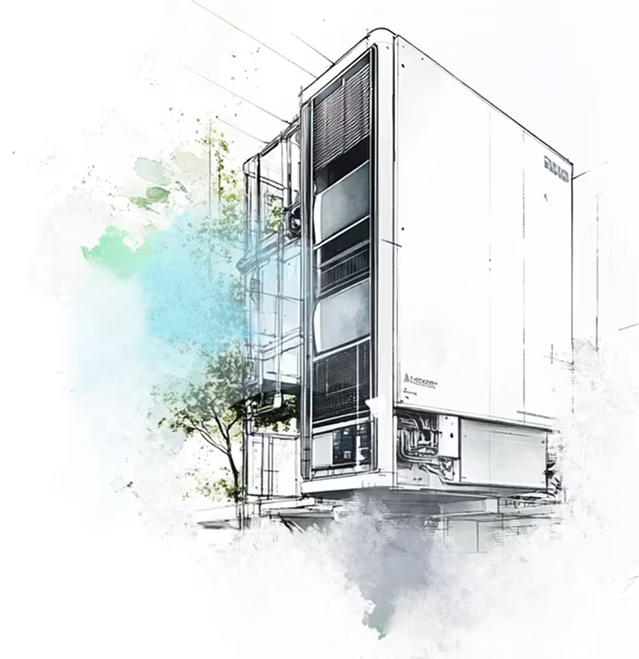As the UK moves closer to its legally binding Net Zero target for 2050, energy efficiency in homes and buildings has become a national priority. With heating responsible for over 14% of the UK’s carbon emissions, addressing the way we warm and power our homes is critical to meeting climate goals and reducing long-term energy costs.
Retrofitting older buildings with low-carbon heating and renewable energy systems is one of the most effective ways to reduce energy use, cut carbon emissions, and protect residents from fuel poverty. Among the many solutions available, combining Air Source Heat Pumps (ASHPs) with solar photovoltaic (PV) panels stands out as one of the most impactful pairings.
This article explores why these technologies work so well together, what the benefits are for households and the environment, and how retrofitting with both systems supports the wider transition to Net Zero.
The Case for Retrofit in the UK
The UK has one of the oldest building stocks in Europe. According to the Climate Change Committee, around 80% of the buildings that will exist in 2050 have already been built. Many of these homes are poorly insulated and dependent on gas heating systems.
To meet climate targets and avoid locking in high emissions, the government has committed to decarbonising homes and workplaces. This includes a major focus on fabric improvements (insulation, glazing, airtightness) and the transition away from fossil fuel-based heating.
In the Heat and Buildings Strategy, the UK Government outlined its plan to phase out gas boilers by 2035, support the installation of 600,000 heat pumps annually by 2028, and expand low-carbon energy generation through solar and wind.
Why Air Source Heat Pumps and Solar PV Make Sense Together
Air Source Heat Pumps and solar PV panels each offer unique benefits. When used together, they create a complementary system that boosts efficiency, reduces carbon emissions, and lowers household energy bills.
1. Air Source Heat Pumps: Low-Carbon Heating
Air Source Heat Pumps extract heat from the outside air and use it to heat indoor spaces and hot water. They run on electricity and are typically 3 to 4 times more efficient than traditional gas boilers, producing more energy than they consume.
- Can operate in temperatures as low as -15°C
- Compatible with radiators, underfloor heating, or a hybrid system
- Eligible for the Boiler Upgrade Scheme offering £7,500 grants
2. Solar PV Panels: Clean Energy Generation
Solar panels convert sunlight into electricity, reducing a household’s reliance on the grid. With energy prices remaining high and the Smart Export Guarantee (SEG), homeowners can also receive payments for excess electricity exported to the grid.
- Can supply electricity to power the ASHP during daylight hours
- Reduces household demand from the grid, lowering bills
- Increases energy independence and resilience
3. Working Together
Heat pumps require electricity. Solar PV generates electricity. Using solar panels to power the heat pump – especially during the day when heating and hot water demand overlaps with solar generation – makes the overall retrofit more efficient.
This synergy maximises self-consumption, reduces grid dependency, and improves return on investment for both technologies.
Energy and Cost Savings: What the Data Shows
Installing both an ASHP and solar PV system can offer long-term savings on energy bills. According to the Energy Saving Trust, households can save between £290–£495 per year by switching from a gas boiler to an ASHP, depending on usage and tariff.
Adding solar panels further increases savings:
- A 4kW solar PV system can save between £250–£550 per year
- Self-consuming solar power reduces the cost of running the heat pump
- Battery storage can add further value, allowing households to store excess solar energy for use during the evening
These savings are amplified in homes that have already undergone fabric-first improvements, such as wall, loft, and floor insulation.
Policy Backing and Funding Support
Government support is helping to make these technologies more accessible.
Boiler Upgrade Scheme (BUS)
- Provides up to £7,500 towards the cost of installing an ASHP
- Available across England and Wales
- Supports both homeowners and small landlords
VAT Relief
In 2022, the government introduced 0% VAT on the installation of energy-saving materials, including heat pumps and solar panels, until 2027. This significantly reduces upfront costs.
Local Authority Delivery (LAD) and Home Upgrade Grant (HUG)
Targeting low-income households and off-gas homes, these schemes fund insulation and low-carbon heating through local councils. Read more here.
Supporting Net Zero: The Role of Skills and Workforce
Installing ASHPs and solar PV systems at scale requires a trained, competent workforce. According to the Construction Industry Training Board (CITB), the UK will need over 250,000 additional construction workers by 2028 to meet demand from Net Zero and retrofit projects.
That includes:
- Heat pump engineers and technicians
- Solar PV installers and designers
- Retrofit assessors and coordinators
- Insulation specialists
- Electrical engineers and system integrators
The skills gap is one of the biggest barriers to scaling up retrofitting. That’s why training providers like Quantum Training are stepping in to address it.
Quantum Training’s Contribution
At Quantum Training, we work with colleges across the UK to deliver practical training in low-carbon technologies. We’ve installed Air Source Heat Pump and Solar PV Training Bays in multiple Further Education (FE) colleges, helping to equip the next generation of installers with real-world skills.
Some of our recent installations include:
- Exeter College: Air Source Heat Pump and Solar PV Training Bays
- Cornwall College: Electrical Ecosystem Training Bays including Solar PV
- Leicester College Green Technology Hub: ASHP and Electrical Training Bays
- Reading College: Air and Ground Source Heat Pumps, Solar PV, and Battery Storage
Our training bays simulate real-world conditions, helping learners understand:
- Electrical installation, solar connection, and battery storage integration
- Compliance with PAS 2035 and other retrofit standards
This hands-on model of training ensures that learners can step into roles that are urgently needed in the retrofit sector.
Designing the Retrofit: What Homeowners Should Know
1. Assess Building Suitability
Not all homes are the same. A detailed retrofit assessment is required to evaluate:
- Insulation levels (walls, roof, floors)
- Window efficiency and glazing
- Existing heating system layout
- Electrical capacity and roof orientation (for solar)
A fabric-first approach ensures that the property is thermally efficient before low-carbon systems are installed.
2. Choose the Right System Size
Oversizing or undersizing an ASHP can lead to inefficiency or poor comfort. Systems should be sized by certified installers using room-by-room heat loss calculations.
Solar PV should be sized based on roof space, energy demand, and potential for battery storage.
3. Understand Heat Pump Performance
ASHPs perform best in well-insulated homes. The efficiency of the system is measured by the Seasonal Coefficient of Performance (SCOP), which averages efficiency across a year.
A well-designed ASHP system can achieve SCOPs of 3.0 to 4.0 — meaning for every 1kWh of electricity, the system provides 3 to 4kWh of heat.
Overcoming Common Barriers
Despite strong policy backing, the adoption of ASHP and solar PV systems still faces several challenges.
Upfront Cost: Although funding schemes exist, the initial cost of installation remains a barrier for many homeowners.
Misinformation: Confusion about system performance, suitability for older homes, and maintenance requirements can deter uptake.
Installer Shortage: A lack of qualified installers creates delays and inconsistencies in quality.
Addressing these barriers requires coordinated action across government, industry, education, and training providers.
Future Outlook
The future of home heating in the UK is electric and low carbon. As electricity decarbonises further through wind and solar generation, using that electricity to run heat pumps and power homes makes both environmental and economic sense.
Pairing ASHPs with solar PV is one of the clearest routes to this future.
- Lower carbon footprint
- Reduced reliance on imported gas
- Greater household resilience
- Growth in skilled jobs and local supply chains
Meeting the government’s target of 600,000 heat pump installations per year and tripling solar capacity by 2035 will require scaling up both technologies and the skills to support them.
Conclusion: A Practical Pathway to Net Zero
Combining Air Source Heat Pumps and Solar PV panels provides a realistic, effective, and future-proof retrofit solution. For households, it means lower bills and better comfort. For the country, it means reduced emissions, stronger energy security, and a skilled green workforce.
Training and education remain the foundation for this transition. At Quantum Training, we’re committed to supporting colleges, educators, and learners across the UK to build the skills needed for this future.
To learn more about our retrofit and renewables training solutions, visit: www.thequantumgroup.uk.com



